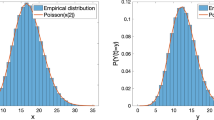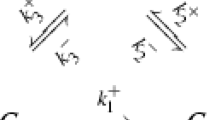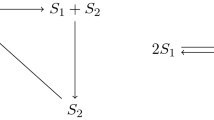Abstract
We consider stochastically modeled reaction networks and prove that if a constant solution to the Kolmogorov forward equation decays fast enough relatively to the transition rates, then the model is non-explosive. In particular, complex-balanced reaction networks are non-explosive.
Similar content being viewed by others
References
Anderson DF, Cotter SL (2016) Product-form stationary distributions for deficiency zero networks with non-mass action kinetics. Bull Math Biol 78:2390–2407
Anderson DF, Kurtz TG (2011) Continuous time Markov chain models for chemical reaction networks. In: Koeppl H, Densmore D, Setti G, di Bernardo M (eds) Design and analysis of biomolecular circuits: engineering approaches to systems and synthetic biology, chapter 1. Springer, Berlin
Anderson DF, Kurtz TG (2015) Stochastic analysis of biochemical systems. Springer, Berlin
Anderson RM, May RM (1992) Infectious diseases of humans: dynamics and control, vol 28. Wiley Online Library
Anderson DF, Craciun G, Kurtz TG (2010) Product-form stationary distributions for deficiency zero chemical reaction networks. Bull Math Biol 72(8):1947–1970
Cappelletti D, Wiuf C (2014) Product-form poisson-like distributions and complex balanced reaction systems. SIAM J. Appl. Math. 76(1):411–432
Chertock A, Kurganov A, Wang X, Yaping W (2012) On a chemotaxis model with saturated chemotactic flux. Kinet Relat Models 5(1):51–95
Childress S, Percus JK (1981) Nonlinear aspects of chemotaxis. Math Biosci 56(3):217–237
Cornish-Bowden A (2004) Fundamentals of enzyme kinetics, 3rd edn. Portland Press, London
Cummings R, Doty D, Soloveichik D (2014) Probability 1 computation with chemical reaction networks. In: DNA computing and molecular programming. Springer, Berlin
Doty D, Lutz JH, Patitz MJ, Schweller RT, Summers SM, Woods D (2012) The tile assembly model is intrinsically universal. In: 2012 IEEE 53rd annual symposium on foundations of computer science (FOCS)
Echeverría P (1982) A criterion for invariant measures of markov processes. Zeitschrift für Wahrscheinlichkeitstheorie und Verwandte Gebiete 61(1):1–16
Ethier SN, Kurtz TG (1986) Markov processes: characterization and convergence. Wiley, New York
Feinberg M (1987) Chemical reaction network structure and the stability of complex isothermal reactors-I. The deficiency zero and deficiency one theorems. Chem Eng Sci 42(10):2229–2268
Herrero MA, Velázquez JJL (1997) A blow-up mechanism for a chemotaxis model. Ann Scuola Norm Sup Pisa Cl Sci (4) 24(4):633–683
Horn F, Jackson R (1972) General mass action kinetics. Arch Ration Mech Anal 47(2):81–116
Ingram PJ, Stumpf MPH, Stark J (2008) Nonidentifiability of the source of intrinsic noise in gene expression from single-burst data. PLoS Comput Biol 4(10):e1000192
Kallenberg O (2006) Foundations of modern probability. Springer, Berlin
Karlebach G, Shamir R (2008) Modelling and analysis of gene regulatory networks. Nat Rev Mol Cell Biol 9(10):770
Kurtz TG (2011) Equivalence of stochastic equations and martingale problems. In: Crisan D (ed) Stochastic analysis 2010. Springer, Heidelberg, pp 113–130
Kurtz TG, Stockbridge RH (1998) Existence of Markov controls and characterization of optimal Markov controls. SIAM J Control Optim 36(2):609–653 (electronic)
Lawler GF (1995) Introduction to stochastic processes. Probability series. Chapman & Hall/CRC, Boca Raton
May RM (2001) Stability and complexity in model ecosystems, vol 6. Princeton University Press, Princeton
Norris JR (1998) Markov chains. Cambridge University Press, Cambridge
Paulsson J (2004) Summing up the noise in gene networks. Nature 427:415–418
Peschel M, Breitenecker F (1984) Socio-economic consequences of the Volterra approach. In: Trappl R (ed) Cybernetics and systems research, vol 2. North Holland, Amsterdam
Peschel M, Mende W (1986) The predator–prey model: do we live in a Volterra world?. Springer, Berlin
Rothemund PWK, Winfree E (2000) The program-size complexity of self-assembled squares. In: Proceedings of the thirty-second annual ACM symposium on theory of computing. ACM, New York
Soloveichik D, Seelig G, Winfree E (2010) DNA as a universal substrate for chemical kinetics. Proc Natl Acad Sci 107(12):5393–5398
Sontag ED, Zeilberger D (2010) A symbolic computation approach to a problem involving multivariate Poisson distributions. Adv Appl Math 44:359–377
Weidlich W, Haag G (2012) Concepts and models of a quantitative sociology: the dynamics of interacting populations, vol 14. Springer, Berlin
Author information
Authors and Affiliations
Corresponding author
Additional information
David F. Anderson: Supported by NSF-DMS-1318832 and Army Research Office Grant W911NF-14-1-0401.
Appendix
Appendix
Let \(E\subset {{\mathbb {Z}}}^d\) and for \(x,y\in E\), \(x\ne y\), let \(q(x,y)\ge 0\) and assume Condition 1 is satisfied. As already discussed in the Introduction, a continuous-time Markov chain on E with transition intensities \(\{q(x,y)\}\) is intuitively a stochastic process \((X_t)_{t\ge 0}\) in E such that
where \(\{{{\mathcal {F}}}_t^X\}\) is the filtration generated by \((X_t)_{t\ge 0}\). There are several ways of making this intuition precise.
Definition 5
-
(a)
The one-dimensional distributions of \((X_t)_{t\ge 0}\) satisfy the forward or master equation if for every \(x\in E\)
$$\begin{aligned} \frac{\text {d}}{\text {d}t}P_t(x)=\sum _{y\in E\setminus \{x\}} P_t(y)q(y,x)-\sum _{y\in E\setminus \{x\}} P_t(x)q(x,y), \end{aligned}$$(18)where the derivative at \(t=0\) is interpreted as a right derivative.
-
(b)
Consider
$$\begin{aligned} {{\mathcal {D}}}(E)=\{f:E\rightarrow {{\mathbb {R}}}: \#\{x\in E:f(x)\ne 0\}<\infty \} \end{aligned}$$and define the linear operator A on \({{\mathcal {D}}}(E)\) by
$$\begin{aligned} Af(x)=\sum _{y\in E\setminus \{x\}}q(x,y)(f(y)-f(x)). \end{aligned}$$Then \((X_t)_{t\ge 0}\) is a solution of the martingale problem for A if
$$\begin{aligned} f(X_t)-f(X_0)-\int _0^tAf(X_s)\hbox {d}s \end{aligned}$$(19)is a \(\{{{\mathcal {F}}}_t^X\}\)-martingale for each \(f\in {{\mathcal {D}}}(E)\).
-
(c)
For \(x,y\in E\), \(x\ne y\), let \((N^{xy}_t)_{t\ge 0}\) be a Poisson process with intensity q(x, y). The stochastic equation for \((X_t)_{t\ge 0}\) is given by
$$\begin{aligned} f(X_t)=f(X_0)+\sum _{x,y\in E :x\ne y}\int _0^t(f(y)-f(X_{s-}))\mathbf{1}_{\{X_{s-}=x\}}\hbox {d}N^{xy}_s. \end{aligned}$$(20)
Remark 2
Note that by Condition 1, for \(f\in {{\mathcal {D}}}(E)\), \(\sup _{x\in E}|Af(x)|<\infty \).
Furthermore, we introduce an additional state \(\partial \) as done in the main text. Solutions of (18) need to satisfy \(P_t(x)\ge 0\), \(\sum _{x\in E}P_t(x)\le 1\) and \(P_t(\partial )=1-\sum _{x\in E}P_t(x)\). Moreover, for solutions of the martingale problem and the stochastic equation, we extend \(f\in {{\mathcal {D}}}(E)\) to \(E\cup \{\partial \}\) by defining \(f(\partial )=0\) and define \(X_t=\partial \), if \(X_t\notin E\).
With this understanding of solutions, it follows that any solution of the stochastic equation (20) is a solution of the martingale problem. Indeed, we can write
where
is a martingale. Moreover, for any solution of the martingale problem, \(P_t(x)=P(X_t=x)\) is a solution of (18): this follows by considering \(f=\mathbf{1}_{\{x\}}\) for \(x\in E\) and by taking expectation (Anderson and Kurtz 2015). The converse of these observations also holds.
Theorem 4
If \((P_t)_{t\ge 0}\) is a solution of (18), then there exists a solution of the martingale problem such that for \(x\in E\cup \partial \), \(P(X_t=x)=P_t(x)\). If \((X_t)_{t\ge 0}\) is a solution of the martingale problem, then there exists a solution \((\tilde{X}_t)_{t\ge 0}\) of the stochastic equation such that \((X_t)_{t\ge 0}\) and \((\tilde{X}_t)_{t\ge 0}\) have the same distribution.
Proof
The first statement follows from Corollary 3.2 of Kurtz and Stockbridge (1998). The second statement can be proved by arguments similar to the proof of (17) in Kurtz (2011). \(\square \)
It follows from Theorem 4 that weak uniqueness for any of the three characterizations implies weak uniqueness for the other two, for a fixed initial distribution. Moreover, the law of a solution to the stochastic equation is uniquely determined up to time \(T_{\infty }\), where \(T_{\infty }\) is defined as in Definition 1. This observation provides the proof of the next result.
Theorem 5
If for a fixed initial distribution \(P_0\) we have \(P(T_{\infty }=\infty )=1\), then there exists a unique process \((X_t)_{t\ge 0}\) with initial distribution \(P_0\) satisfying any of the three characterization of Definition 5.
We conclude with the following result, which can be read from Ethier and Kurtz (1986, Theorem 9.17 of Chapter 4) and is due to Echeverría (1982).
Theorem 6
If \(\pi \) is a constant solution to the forward Kolmogorov equation, namely if
then there exists a solution of the martingale problem which is a stationary process with stationary distribution \(\pi \).
Note that under the hypotheses of Theorem 6, Theorem 4 implies the existence of a solution to the martingale problem with \(P_t=\pi \) for all \(t\ge 0\), and a stationary solution to the stochastic equation (20).
Rights and permissions
About this article
Cite this article
Anderson, D.F., Cappelletti, D., Koyama, M. et al. Non-explosivity of Stochastically Modeled Reaction Networks that are Complex Balanced. Bull Math Biol 80, 2561–2579 (2018). https://doi.org/10.1007/s11538-018-0473-8
Received:
Accepted:
Published:
Issue Date:
DOI: https://doi.org/10.1007/s11538-018-0473-8




